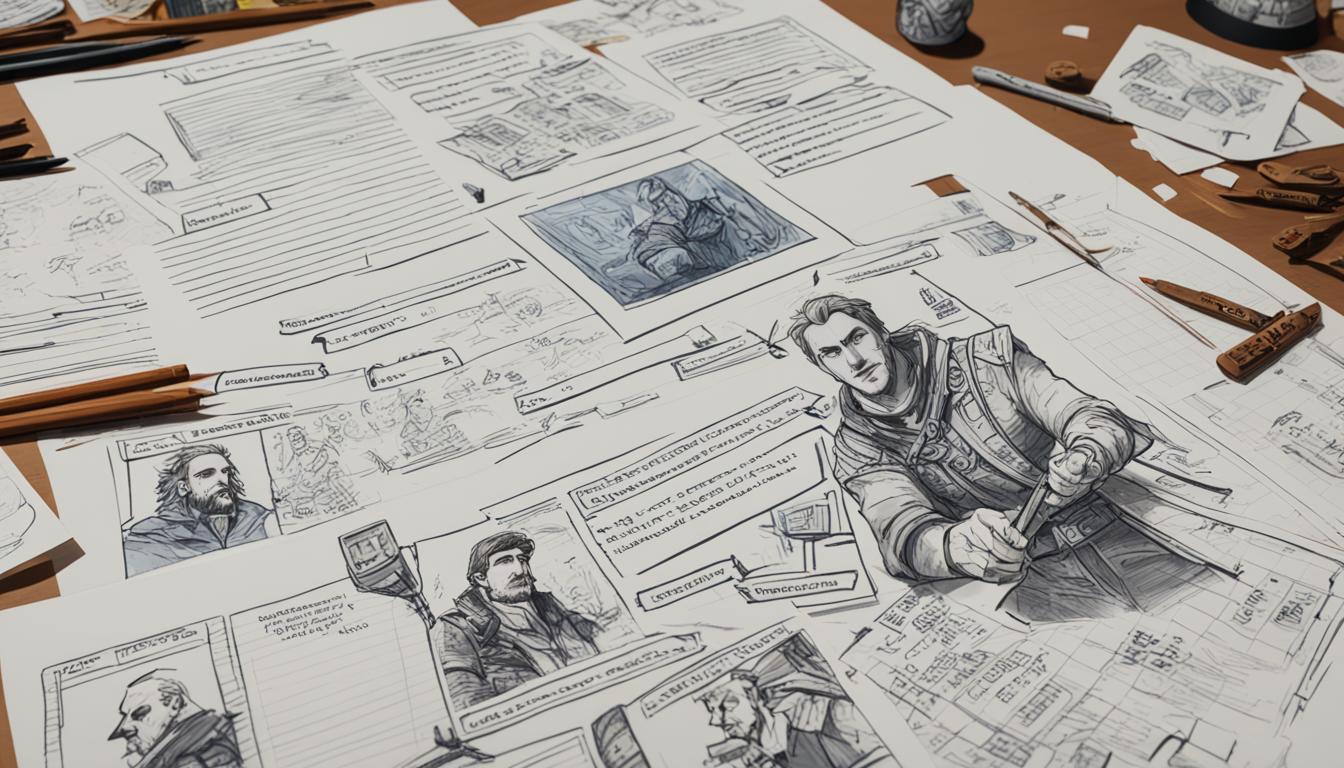Improving Storytelling in D&D: A Guide for DMs
Welcome to my guide on boosting storytelling in Dungeons & dragons! As a Dungeon Master, I know how vital it is to grab players’ attention, build worlds in their minds, and make the adventures unforgettable. In this guide, I’ll share some tricks and tips to make your stories more captivating. It’s for both new and seasoned DMs.
Every great D&D campaign starts with an amazing story. It breathes life into the game world, holds players spellbound, and propels the journey ahead. By mastering some key storytelling methods, you can take your games from good to great. You’ll create gaming memories that last a lifetime.
I’ll dive into several storytelling areas for Dungeon Masters. This includes the art of storytelling in D&D, how to create characters that players will remember, and plot twists that will surprise and thrill. We’ll also go over how to give players a say in the story, build worlds that feel real, and weave interactive parts into your tales.
Moreover, I’ll share useful advice for sharpening your storytelling skills, tailoring your tales to different player types, and dealing with unexpected player moves. We’ll talk about how to use dialogue to drive the story and how drawing inspiration from various sources can make your D&D games better.
Whether you want to refine your story-developing techniques, get better at engaging players, or seek new ideas for plot twists, this guide is here to help. Let’s start this storytelling journey. Together, we’ll make your D&D adventures truly unforgettable!

Key Takeaways:
- Engage players and enhance immersion in your D&D campaigns through effective storytelling techniques.
- Understand the multi-faceted role of the Dungeon Master in crafting engaging narratives.
- Embrace player agency to create interactive and dynamic gaming experiences.
- Create detailed and immersive worlds using scene-setting techniques.
- Construct descriptive and dynamic narratives while maintaining an appropriate pacing.
Understanding the Art of Storytelling in D&D
Storytelling is the bedrock of every Dungeons & Dragons (D&D) campaign. As the Dungeon Master (DM), you transport players into worlds of adventure and intrigue. This part will explore how to tell captivating stories in D&D. We’ll look at the DM’s crucial role and why player choice matters.
Defining Storytelling within the Realm of Dungeon Masters
Telling a story in D&D is more than just listing events. It’s about creating tales that pull players in, making them feel and imagine. You, as a DM, shape a lively world where players truly affect the story. This is done through stories that immerse gamers and make their experiences memorable.
The Multi-Faceted Role of the DM in Crafting Narratives
You wear many hats in D&D storytelling. You start as the narrator, painting scenes, and bringing NPCs to life. Then, you craft storylines rich in mystery and excitement, mixing main and side plots. You also play the game’s referee, ensuring the story runs smoothly while the game follows its rules.
Finally, you’re an improviser, ready to adjust the story as players make decisions. Being ready for change is crucial to keeping the story engaging and interactive. This adaptability is what makes D&D storytelling unique.
Embracing Player Agency Within Your Story
Player agency is about letting players shape the story through their choices. It’s essential for D&D as it makes players care about what happens, adding to the story’s depth. By giving players real control, you help make the story feel like a joint effort.
It’s key to balance your prepared story with allowing player choices. Offer them options that matter, and let them develop their characters. This mix makes the storytelling process more cooperative and fun for everyone involved.

Setting the Scene: Techniques for Immersive World Building
Creating immersive campaigns in Dungeons & Dragons relies on strong world building. It’s up to the Dungeon Master to whisk their players into a vivid, engaging world. I’ll share some tips to help you craft environments that grab your players and don’t let go.
To start, craft detailed, vivid descriptions. Describe each location, landscape, and atmosphere with rich detail. This makes the world come alive for your players, pulling them into the game.
Also, use sensory details to make the world feel real. Talk about the weather, the light, the smells, and the sounds. Engaging all the senses helps your players feel like they’re truly there.
Creating memorable NPCs is key. Give these characters unique traits and stories. Having players interact with them via roleplay enhances the game’s immersion and creates unforgettable moments.
Visual aids can also enhance your game. Maps, illustrations, or miniatures can help players visualize the world. They’re great for showcasing locations and adding to the storytelling.
Encourage player exploration. Create areas with hidden treasures and secrets. Reward curiosity with new discoveries. This keeps the game fresh and exciting for your players.
By using these techniques, your Dungeons & Dragons campaign can become both exciting and memorable. A detailed and immersive world draws players in, making their experience more enjoyable and engaging. So, focus on creating a world that feels truly alive.
Mastering Narration: Keeping Players Engaged
Constructing Descriptive and Dynamic Narratives
In Dungeons & Dragons, telling the story is more than just giving facts. It’s a chance to pull players into the world you’ve built and fire up their dreams. To make your tales vivid and exciting, try these tips:
-
Create Vivid Visuals: Describe with flair to create a mental picture. Involve the senses by detailing the scenery, sounds, and scents. This makes the world around them feel real.
-
Develop Multidimensional Characters: Give your NPCs life through unique traits and relationships. It deepens the story and fosters emotional bonds between players and characters.
-
Use Engaging Dialogue: Dialogue breathes life into your story. Make it informative, tense, or revealing of a character’s nature. Remember to keep it real with fitting pace, tone, and words.
Pacing Your Story: When to Delve Deep and When to Summarize
Keeping up the pace keeps players interested. Knowing when to slow down for big moments and speed up in between is crucial. Here are some tips:
-
Build Suspense: Amp up intense scenes with slow, detailed storytelling. This makes events more gripping and exciting.
-
Summarize Mundane Tasks: Skip the long details for things like long travel or shopping. It helps keep the story moving without getting dull.
-
Allow Space for Player Interaction: Give players chances to make choices that affect the story. This makes them feel more involved and keeps things exciting for everyone.
With good storytelling and pacing, you can craft a tale that draws in players and makes them love the adventure.

Character Development: Crafting Memorable NPCs
In the world of Dungeons & Dragons (D&D), memorable non-player characters (NPCs) are key to a good campaign. They make the game world feel real and enhance the story. As a Dungeon Master (DM), you need to create NPCs with deep backgrounds that players can connect with.
Create NPCs with their own goals, motivations, and personalities. Decide if they are a friend, a foe, or someone with complex feelings. This approach makes characters more real. Players will engage with the story better.
Great backstories can really bring NPCs to life. They give characters history and make them more relatable. Think about their past, relationships, and key experiences that shaped who they are.
Add specific details or traumas to make NPCs more memorable. These backgrounds influence how players interact with them in the game. Backstories can drive the story forward in interesting ways.
Well-thought-out backstories also offer quest opportunities. NPCs’ personal quests might tie into the main story, making players want to help them. This can add depth and realism to the game world.
Character development is at the heart of creating great NPCs in D&D. By focusing on their goals, motivations, and stories, you’ll enrich your game. Putting effort into fleshing out NPCs is rewarding. It makes your game more captivating for players.
| Key Elements of Memorable NPCs | Benefits of Well-Crafted Backstories |
|---|---|
| Goals and motivations | Enhanced player engagement |
| Personality traits | Realism and depth in character interactions |
| Role within the game world | Source of plot hooks and quest opportunities |
| Relevance to the main story | Immersive storytelling experiences |
Creative Plot Structure: Designing Campaign Arcs
Designing an intriguing plot structure is key to making engaging Dungeons & Dragons campaigns. A Dungeon Master needs to craft storylines that allow for player choices. These stories should draw players in and keep them involved.
Establishing Coherent Plotlines with Room for Divergence
Start by outlining key story elements and goals. This sets the path for the adventure. Along with the main plot, include optional paths for player choices. This lets players influence the story.
Players should feel their actions matter in the game. Let them make important decisions and guide the story. Include quests tailored to their characters, making the game more personal and exciting.
Injecting Mystery and Suspense into Campaigns
Mystery and suspense make stories memorable. Add puzzles and hidden secrets. These elements grab players’ attention and make them curious.
Place hints and clues for the players to find. These subtle details tell parts of the larger story. Encourage players to explore and interact to discover the mystery.
Surprise your players with unexpected events. Twists like betrayals or hidden identities are great. They will keep players guessing and eager to know more.

Designing Campaign Arcs
| Technique | Description |
|---|---|
| Plot Outlining | Create a detailed outline of the main story elements, conflicts, and objectives. |
| Player Choice Design | Incorporate branching paths, choices with consequences, and multiple possible resolutions to allow players to shape the story. |
| Quest Diversity | Create different storylines or quests based on player choices, alignment, and personal goals, providing a tailored and unique experience for each player. |
| Clue Placement | Introduce clues and hints throughout the campaign to unravel a larger mystery and engage players in solving it. |
| Plot Twists | Incorporate unexpected turns of events, betrayals, or hidden identities to deepen mystery and suspense. |
Interactive Story Elements: Engaging Players in the Narrative
Interactive story elements are key for pulling players into the tale. By adding these features, players can influence the story. They choose how the narrative unfolds through their decisions and actions. This makes the experience more engaging and alive.
In a game like D&D, keeping the players committed is vital. The Dungeon Master lets the players steer the story’s path and ending. This makes them feel like the story is their own. There are many ways to do this:
- Providing meaningful choices: Present players with decisions that have significant consequences within the narrative, allowing them to feel invested in the outcome of the story.
- Incorporating interactive puzzles and challenges: Engage players by introducing puzzles, riddles, and challenges that require their problem-solving skills to progress through the story.
- Implementing branching storylines: Design the narrative in a way that diverges based on player choices, offering multiple paths for players to explore and shaping the story based on their actions.
These interactive features give players control and immerse them further. When players can shape the tale, they get more into the game. Their part makes the story richer and more engaging.
Improving Storytelling in D&D
To get better at telling stories as a Dungeon Master (DM) in Dungeons & Dragons, practice is key. Some tips can help you sharpen your skills and make your D&D stories even more captivating.
Practice Makes Perfect: Tips for Honing Your DM Skills
First, share stories outside the game. You can write short tales or roleplay with friends to get better at storytelling. This practice helps you improve.
Next, learn different ways to tell a story. Read books, watch movies, and see plays by famous creators. Take note of how they build their tales. Use these lessons in your DM style.
Also, try unique ways to tell stories. Experiment with styles like jumping back and forth in time or letting your story’s voice lie. This makes your D&D games more interesting.
Don’t forget to ask your players for feedback. Getting their perspective can show you where you can get better. Listening to them and making changes improves everyone’s fun.
Lastly, be ready to think fast. When players do something unexpected, adjust your story on the spot. This skill keeps your game exciting and immersive.
Inspirational Resources to Elevate Your Storytelling
To make your stories better, check out a range of resources. Things like books, podcasts, or online communities can offer great insights and tips.
- Start with books about storytelling. They cover how to make characters, build worlds, and tell tales. Two good books are “The Hero with a Thousand Faces” by Joseph Campbell and “Elements of Fiction Writing: Characters & Viewpoint” by Orson Scott Card.
- Podcasts and blogs are also helpful. They have interviews and discussions about being a DM. This content offers fresh ideas and helpful suggestions.
- Join online groups and forums. Places like Reddit and Discord let you talk with other D&D lovers. You can share stories, ask for advice, and learn a lot from the community.
- Don’t miss events like workshops and conventions. They focus on storytelling and DM skills. You’l meet experts and get to see their techniques in action.
By staying curious and using all these resources, you can keep getting better at telling stories. This will make your D&D adventures more fun and memorable for everyone.

Adapting Your Storytelling Style for Different Player Groups
Player groups have their unique styles and needs. As a Dungeon Master, it’s vital to adjust how you tell stories. Knowing what your players like and how they react helps a lot. This ensures they dive deep into the world you create.
Reading the Table: Adjusting Stories for Player Reactions
Being able to ‘read the room’ is crucial for any Dungeon Master. Watch how your players react to your stories. This includes their words and body language. Use this to see if they’re liking the story and tweak things as needed.
To really draw them in, use vivid details and exciting tales. If certain parts of your story just don’t grab them, don’t worry. Just be ready to change things up to better fit what they enjoy. This will make them feel part of the adventure.
It’s always wise to listen to what your players say about the story. Their feedback can be pure gold. It sheds light on what’s working and what can be better. So, make use of their thoughts to improve the story for everyone.
Customizing Campaign Themes to Match Group Preferences
Customizing the story to fit what your players like makes a big difference. Talk to them about what kind of adventures they enjoy most. Then, work those elements into the story you’re building. This can make the game more fun and personal for them.
Keep the adventure exciting with quests and storylines that match your players’ interests. This helps them feel like their characters are on a journey they helped shape. It makes your storytelling more personal and memorable for everyone.
Remember, it’s not about pleasing every single request. It’s about finding a good mix that the whole group enjoys. With your role as the Dungeon Master, aim to keep the story interesting yet coherent. This will make the adventure something they all look forward to every time.
| Player Group | Storytelling Approach |
|---|---|
| Narrative-driven | Focus on rich character development and intricate plotlines. |
| Combat-focused | Emphasize thrilling battles and tactical encounters. |
| Exploration-oriented | Create expansive and detailed environments to explore. |
| Social and roleplay-heavy | Provide opportunities for deep character interactions and meaningful choices. |
Adjusting how you tell stories to fit your players makes the game come alive. It ensures that they have a great time while getting deeply involved in the adventure. This way, they enjoy the story and the game more.
Integrating Player Characters into the Story When running a Dungeons & Dragons game, it’s crucial to blend the player characters (PCs) into the tale. Doing this lets the players feel like they are part of the adventure. It pushes their characters to evolve and develop. Here’s how you can do it smoothly:
-
Connect their backstories: Spend time diving into each PC’s backstory when setting up the campaign. Find ways to weave their personal stories into the main one. This adds depth and motivation to each PC.
-
Engage them with the world: As the Dungeon Master, make the world come alive for the players. Have NPCs offer quests, spread rumors, or ask for help. This makes the PCs essential to the story.
-
Create character arcs: Let the PCs evolve throughout the story. Design situations that challenge them and spur growth. You can include moral tests, personal obstacles, and chances to overcome flaws.
-
Adapt the story to their choices: Giving players the freedom to shape the story is key. Be ready to adjust as they make choices. This way, their decisions truly matter and change the course of the game.
By deeply involving player characters into the story, you, as the Dungeon Master, can make gameplay more immersive and enjoyable. The feeling of owning a part of the story will amp up player satisfaction and fun.
Narrative Challenges: Handling Unexpected Player Actions
Running a game like Dungeons & Dragons brings many joys, including players’ wild unpredictability. These surprises can throw a wrench into your story’s smooth sailing. Adapting to and dealing with these unexpected actions while keeping the story engaging is key.
Maintaining Narrative Flow During Surprises
Players often do the unexpected, moving away from your planned path. It’s vital to stay flexible and quick on your feet when this happens. Here’s how:
- Quick Thinking: Improvising and making changes instantly is a must. Knowing your world deeply and having creative ideas ready to go will save the day.
- Reacting Naturally: Think about how the world and its characters would realistically react. This keeps everything believable and immersive.
- Assessing Consequences: Think about the outcomes of these sudden actions. Decide how they will shape the story so it still makes sense.
Plot Twists and Player Choices: Striking a Balance
Plot twists can spice up your story, making it more thrilling for everyone. Yet, it’s crucial to let players feel they have control over their characters’ fates. Here’s a way to balance the surprise with player freedom.
- Establishing Foreshadowing: Early hints and clues can preview upcoming surprises. This makes players feel part of unraveling the story’s mysteries.
- Giving Meaningful Choices: Let players make decisions that really change the story. This approach not only makes the game more engaging but also empowers your friends to feel their impact.
- Being Adaptable: Don’t fear when players steer off course. Instead, use their choices to introduce new surprises into the story. It makes the game more alive and full of unexpected delights.
Welcoming the unexpected from players, and mixing it wisely with your story’s twists, can make the tale spellbinding. Always remember, some of the best moments come from the surprises players bring to the table.

The Power of Dialogue: How to Create Compelling Conversations
Dialogue in Dungeons & Dragons goes beyond words. It’s a key tool for making characters real, building strong connections, and pushing the story ahead. Good dialogue in D&D makes character talks better and the game more fun to play. Here, you’ll learn how to make conversations in your D&D game that people remember.
-
Show, Don’t Tell: Ask your players to act out what their characters say. This makes the game more real. It helps players really get into their character’s feelings and thoughts.
-
Create Conflict: Drama comes from conflict. Add different views, secrets, or personal goals to your game. This makes the story more exciting as characters deal with these problems.
-
Use Descriptive Language: Making words vivid adds a lot. Use language to give your scenes mood and feeling. It helps players see the story in their minds.
-
Listen and Respond: It’s key to pay attention to what players say and do. React to their choices. This shows them their actions matter and makes them feel valued in the story.
-
Utilize NPCs: Non-player characters can shape the story a lot. Make these NPCs stand out with their own personalities and goals. This will lead to great talks and move the story ahead in interesting ways.
-
Inject Humor: Comedy not only makes the game fun but also deepens friendships between characters. It creates moments everyone will remember and makes the game more lively.
Focusing on great dialogue can really improve your game. Good talks make the story richer and draw everyone in more. Remember, it’s not just the fights or journeys. Conversations between characters can be really powerful too.
Narrative Bonus Tips: Taking Inspiration from Other Media
Adding elements from movies and books can really boost your D&D game. Pulling from novels, films, and theater can bring fresh ideas and exciting twists. This makes your storytelling more interesting.
Novels are awesome for making strong characters and rich worlds. By reading good stories, DMs can pick up cool ways to keep players hooked. They also help in making NPCs that feel real, giving players important links in the game world.
Films show us how to tell stories visually. Things like camera angles and stunning scenes can be described to players. This helps everyone feel like they’re really in the game’s world.
Using media as a guide for adventures works well. Looking at how stories and characters are built in movies and books helps. It can turn your D&D quests into thrilling tales that players will never forget.
Conclusion
Throughout this article, I’ve given you tips for better storytelling in Dungeons & Dragons. These methods will help you make your game more captivating and fun. You can bring your players into a story they won’t forget.
Keep improving by practicing and enhancing your storytelling. The better you get, the more your sessions will shine. Don’t give up; keep working on it.
D&D thrives on immersing players in its worlds. By giving players choices, painting vivid scenes, creating exciting stories, and crafting unique characters, you can build an unforgettable adventure.
Now, equipped with the advice in this guide, unleash your imagination. Your team is eager for a new journey. Craft a narrative that will be remembered for years to come.